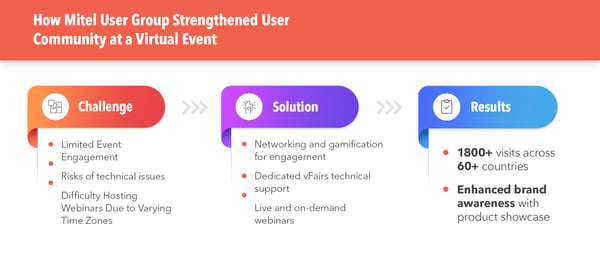September 6, 2023
 by Muhammad Younas / September 6, 2023
by Muhammad Younas / September 6, 2023

The American Educational Research Association (AERA) runs one of the biggest conferences in the US, with more than 650 sessions taking place across 6 hotels and live-streamed for virtual attendees.
The turnout for these is in the thousands! Industry leaders lauded organizers for creating the most recent conference’s seamless experience on Twitter (now X).
Now, AERA is an exemplary conference facilitator, but they’re no longer the outlier. I have watched thousands of organizations scale to this extent over the last decade, pragmatically embracing events as the key component of their marketing strategies.
The conference season is upon us, and event marketers are busy preparing for their sales teams’ attendance. It’s the perfect time to read this so you can assess whether your endless badge scans tie to business outcomes or if you’re burning money in the name of a marketing play.
Events are expensive, but they’re a necessary investment because they attract prospects and drum up business. However, showing the impact of events isn't always straightforward. The leads you make at events may not convert immediately – or at all. Does this mean they’re a waste of your effort?
Yes. If you’re doing them as a random act of marketing.
Your problem is your failure to align events with your overall business KPIs. This is where I start with customers who want to host a new event.
Over the past couple of years, I’ve witnessed our client base prioritize events as ways to build community and strengthen consumer relationships, not just chances to drive sales. Plan to evaluate brand awareness, behavioral data, and feedback straight from the mouths of prospects if you want to get everything you can from your events.
Event marketers should take calculated risks with their event marketing strategies to optimize returns. Being aware of the current event landscape and a willingness to adapt helps create positive outcomes.
One of our clients, Harbor Wholesale, took a bold step by transitioning their traditional, in-person trade show to a virtual one. But, they were concerned about providing the look and feel of a live event and maximizing a virtual show experience for their retailers. They wanted to allow vendor partners to offer deals, collect orders, showcase new items, and network virtually.
Changing your event format is a big leap, and I admire companies who are taking it and embracing technology along the way. Fortunately, for Harbor Food, this adjustment in strategy helped them increase sales by 35% compared to their most recent in-person event.
Not only this, but they were also able to:
The sun is setting on third-party cookies, and data gathering is shifting to a cookieless future for better customer experience and data privacy. This challenges us marketers. Without cross-site data tracking and third-party sourcing, we’re left searching for solutions to:
At this stage, marketers cling to first-party data like a life preserver. Hosting events is a great way to capture data from attendees who are already customers or who know what issues they face and are now exploring product solutions.
In fact, our own product team has put a significant amount of time into creating better event-tracking and reporting systems over the last few quarters as a direct response to our clientele’s growing demand for more stats and data from their events.
With the right event technology, you eliminate manual data collection and add efficiency to workflows, making it easier to track and analyze data at multiple touchpoints.
Remember these touchpoints for your next event:
We recently worked with Metaschool, a Web3 startup comprising 13 team members. Metaschool wanted to launch its program to a larger group of web developers. It was a massive undertaking, so they decided to create virtual boot camps to keep everyone connected.
From setting up the landing page to automating email campaigns, everything was implemented within the vFairs platform. The coding camp attendance went up 60%, and their participant pool grew at a steady rate of 35% per session over 11 months. The event was a huge success that started with 20 developers enrolled and 300 just waiting to sign up. Metaschool was able to expand the reach of its program by staying true to its vision and delivering value to attendees.
Their success is why you have to create content that’s tuned into the sound of your target audience. Events are a powerful tool for delivering tailored content. With careful planning, you can host thought-provoking keynotes, interactive sessions, and specialized workshops that drive real value for your audience.
Brands juggle between nurturing existing relationships and forging new connections. Fortunately, events have revealed themselves as powerful tools for engaging with both current clients and likely prospects to shape future growth.
Events are now platforms that celebrate valued relationships and demonstrate ongoing commitment. By inviting existing customers to events designed according to their interests and needs, you reinforce your loyalty to them.
At vFairs, we host an annual user conference called DiscoverNext that focuses on issues within the event technology space. It’s open to clients and prospects, and last year’s event resulted in 550 registrations. Based on the average price of a virtual event, we generated a 13x ROI.
Events also offer an ideal setting to unveil products and services to newer audiences. Prospects will engage during dedicated sessions, workshops, and interactions that match their unique interests. This personalization ensures that they leave with a positive perception of your brand.
Events are beneficial. But you can't just show up and expect instant results. I’ve seen companies host events only because it felt like the right thing to do for their business. When they get dismal results, they’re confused about what went wrong. Clearly, they jumped a step or two that led to this outcome.
You need a solid plan, and at its heart lies proper research. It provides insights into what's trending and how competitors are hosting their events.
When you invest in in-depth research, I’ve seen a positive impact on several aspects:
Comprehensive audience profiling acts as a foundation for your event planning. Segmenting your target audience into distinct groups allows you to create personalized experiences, increasing the likelihood of engagement. By addressing the pain points of your audiences through your event content, you position your event as a means to find a solution to their challenges.
Knowing specifics about the target audience leaves a huge impact on the content, format, promotional plan, and event layout. You can choose between in-person, virtual, and hybrid events to cater to the requirements of your specific audience. For example, if your audience is based worldwide and travel isn’t an option for the entire group, a hybrid or virtual event might be a better option than in-person.
Proper research also allows you to strategically choose session formats and add interactive elements to enhance the impact. For example, when hosting a lecture, add roundtables and panel discussions to engage the audience on another level.
While the content and engagement are pivotal, the logistics form the backbone that holds your event together. Researching venues ensures that the chosen space aligns with your event's theme and size. You can partner with vendors, suppliers, and sponsors through research to ensure seamless event execution. This also allows you to make informed decisions about budget distribution and achieve your event goals.
Going back to the American Educational Research Association, hosting 650+ sessions with 100+ sessions taking place simultaneously was a massive undertaking, logistically speaking. What worked well in their case was how they incorporated event technology to accommodate attendance. The attendees created personalized agendas and tracked the sessions they wanted to attend. This allowed them to cut through the noise of 100+ sessions happening simultaneously.
What’s more fascinating is the buzz their conferences created. People shared their experiences on Twitter (now X). Essentially, a seamless experience does wonders for event organizers, exhibitors, and attendees.
When you define measurable KPIs aligned with your event goals, it helps you better analyze the performance. By researching technology solutions, you can select tools that enable real-time data collection and analytics during the event. Post-event analysis based on data insights helps you identify areas for improvement and refine future event strategies.
People famously believe that luck leads to success, but I disagree.
Today, we are equipped with so much data, success stories, and solid examples that we don’t have to make guesses and shoot in the dark.
Successful event marketers are always doing something that catches my eye. Before and after events, I get slammed with emails – we all do. But the ones that stand out really lean into personalized insights. They go the extra step to understand what I did or didn’t do at the event.
For instance, I get an email stating, “Younas, I saw you attended sessions A, B, and C but couldn’t attend X, Y, and Z, which were related topics. Here is the on-demand recording of these sessions so you can watch them anytime.”
I’m a busy person, so catching everything at an event might not be an option. An email packed with this type of value gets my attention and respect.
In order to evaluate event success, concentrate on these key metrics:
In the dynamic realm of events, data isn't just a resource. It’s a potent tool that empowers companies to improve ROI, shape successful strategies, and successfully engage their audience.
But is there an easy way to measure success? Five years back, events weren’t big on technology, but now organizers are more receptive. Attribution always becomes a little less painful if you can use event technology to track activity before, during, and after the event.
Before the event :
During the event:
After the event:
When it comes to marketing, if you’re not using events, you’re already behind. They stand as one of the most empowering tools for accomplishing your marketing objectives. From building brand awareness to fostering thought leadership, events offer a dynamic platform to strike a chord with your target audience.
Events pave a unique route for companies to establish lucrative partnerships with new sponsors. Collaborating with corporate partners enriches your event's value proposition and unlocks opportunities for shared success.
Since 2018, the National Urban League has been pairing up with vFairs to host an annual conference. Their most recent event saw a 200% increase in attendance, which eventually led to new revenue streams for them. There is an opportunity for absolutely any company and industry to benefit from events, granted they’re vision is clear.
Customer relationships are your business’s lifeblood, and your events catalyze the ways you nurture these new relationships and build community. Just look at the Mitel User Group Annual Event. At their last event, they shared how they managed to enhance customer relationships, strengthen brand loyalty, and solidify their position as a customer-focused industry leader.
 Source: vFairs
Source: vFairs
Source your prospective customers with attendee interactions, registrations, and engagement. Events even allow you to rekindle the interest of cold leads by providing them with new, valuable content and engaging experiences. The dormant leads can awaken so they can move down the sales funnel.
You get to diversify your target audiences and customer bases at events. Companies can tap into new markets and industries with a tailored approach that rings true with the challenges new audiences face. Typically, our trade show clients value meeting prospects face-to-face to make a memorable impression and nurture them later with follow-ups. They’re reluctant to do virtual events because they don’t think they’ll get the same level of engagement or reach. But clients like OGC Global host virtual property trade shows and end up with a 50% attendance compared to 30% for onsite events.
You can position your company as a thought leader by hosting expert panels, informative workshops, and industry discussions. These kinds of events support brand credibility and trust. Meaningful interactions shape how attendees perceive your brand.
Events are ideal for flaunting new products and services. Attendees get firsthand experience before anyone else does, enabling them to understand features and benefits dynamically. The best part is that you can collect immediate feedback on new work during the event so you can refine products based on real-time insights.
Even with the best methods, pitfalls are bound to hinder the effectiveness of your event marketing strategy. Let’s talk about how you can lower your chances of making these way-too-common mistakes.
Events must serve a purpose beyond spectacle. Companies think doing events is a good idea, but they often don’t invest time in mapping out how these events tie back to their business KPIs. Identify this specific goal and then center your marketing efforts around it. If events don’t return your efforts, don’t invest in them.
The event landscape shifts quite frequently, with new innovations around every corner. As technology has evolved, attendee’s expectations from events have changed as well. As a host, you need to adapt and come up with creative solutions to offer an interactive and engaging experience.
Event organizers stick to traditional event formats, and it doesn’t work out for them because grabbing attendee attention has become more challenging than ever.
Five years back, a conference that focused purely on content dissemination would have worked fine, but people already had many avenues of networking at work. Since more professionals are working remotely, they look for networking opportunities at events. Take advantage of their search to design the events your attendees want.
Historically, a press release has been the go-to medium for announcing an event, but it isn’t the only path available to event marketers anymore. In an era of multi-channel engagement, apply a holistic method. Utilize email marketing, LinkedIn, and TikTok to promote your event to a broader audience.
As an organizer, you have the opportunity to harness the power of data collection to your advantage – don’t fail to do so.
Neglecting event performance and its analysis is a mistake. It results in wasteful resources and an inability to identify areas of improvement. Make use of event technology to measure your performance.
What you write in your follow-up communication matters. Outdated and generic messaging with prospects undo the positive impressions of your event.
When you follow up with attendees, reference the interactions you had with them during the event. This helps them remember who you are, so they don’t need to connect the dots. Your leads also appreciate the effort you take to personalize outreach instead of just sending a template.
Include resources in your emails that align with the interests and challenges they mentioned to you at the event. This tailored approach reinforces the value of networking with your company.
Through meticulous planning and innovative execution, you can craft events that enhance your brand identity, hit new revenue goals, and give you the info you need to make smart decisions for your business.
Success looks different on each type of event you host. For conference organizers, winning may include expanding reach and enhancing engagement. A trade show host may aim for higher sales, while a hiring fair committee could be focused on finding new talent.
Despite the diverse metrics for each use case, hosts need to guarantee that attendees are immersed in the tailored experience you’ve made for them. The more opportunities for engagement and connection, the more your events will resonate with your prospects. They‘ll remember the effect far beyond the event's duration, look forward to your follow-ups, and join your demo calls with an open mind.
The good news is that with event technology like vFairs, you can achieve all this for your events, no matter the size, type, or setting.
This post is part of G2’s Industry Insights series. The views and opinions expressed are those of the author and do not necessarily reflect the official stance of G2 or its staff.
Muhammad Younas is the Founder and CEO of vFairs, an all-in-one event platform that provides innovative solutions to businesses around the world to help them run their in-person, virtual, and hybrid events. With over 15 years of experience in the technology industry, Younas has a proven track record of building successful businesses that drive growth and innovation. Under Younas's leadership, vFairs has become a global leader in the event tech space, offering a cutting-edge platform that enables businesses to host engaging and immersive events online. vFairs has served clients across 100+ industries, including government, education, technology, healthcare, telecom, and non-profits, among others.
As the digital world moves toward a cookie-free environment, marketers must source first-party...
 by Muhammad Younas
by Muhammad Younas
Content marketing plays a key role in both customer acquisition and retention.
 by Neelam Goswami
by Neelam Goswami
AI is no longer just helping B2B buyers; it’s making decisions for them.
 by Alexandra Vazquez
by Alexandra Vazquez
As the digital world moves toward a cookie-free environment, marketers must source first-party...
 by Muhammad Younas
by Muhammad Younas
Content marketing plays a key role in both customer acquisition and retention.
 by Neelam Goswami
by Neelam Goswami


